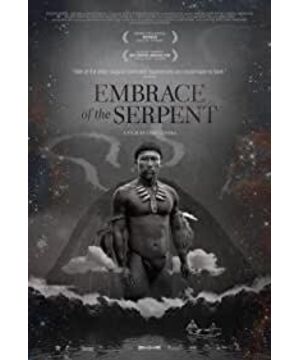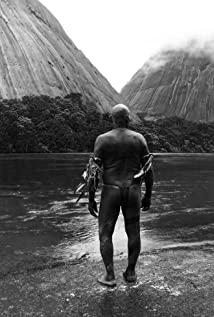There is too much to go into here if you want to scrutinize it layer by layer. Simply separating the two levels, the surface is like the reproduction of the British Joseph Conrad's novel "The Heart of Darkness". It is also the white people occupying the homes of the indigenous people, brutal and oppressive forcing them to become slaves and looting their natural resources frantically. There are also civilized people who rush to the virgin forest to dominate, and the "white devil" appears to be a degenerate character like wisdom, and the confrontation between colonization and anti-colonization. Inside, the traditional teachings of the Kovano tribe are used to bring out the Buddhist concept of "the heart produces all things", especially in the character of the shaman Karamakate-he has always believed that dreams are more real than reality, and people's hearts are more full of feelings. Paper records are more important. Only by following your heart can you find your way.
The story begins in 1909 by the Amazon River. Karamakate, the shaman, lives in isolation from the world. He sadly considers himself the only remaining member of the Cohiuano tribe. Until one day suddenly two "outsiders" came in and asked for his help. One of them was an indigenous person who was enslaved by whites to gather rubber. Later, he was rescued by Theo, a German ethnologist who was next to him, and stayed with him as his traveling companion. Now that the Germans are suffering from serious diseases, they can't heal them with every possible means. Shamans are called people who can "reverse the world", and they come to ask for help. The priests actually hated the white people because the Colombians used their money to cultivate and destroy their lands. However, after hearing Theo said that there were other people in the upper reaches, he finally agreed to walk with them to find the people and pick the sacred larks in the group. Yakruna cured Theo's disease.
Time flashed to 1940, when the priest Karamakate was aging. He said that he hadn't heard the stone speak for a long time, and he couldn't hear the voice of all creatures, and his memory began to blur. At this time, an American botanist Evans came to him to inquire about the precious and sacred herb Yakruna. After hesitating, he decided to help him and start the journey to find Yakruna again. The Yakruna here is actually a fictitious herb that has the effect of a hallucinogen. It helps the Kovano people in their dreams to relieve their illness and makes them a sacred existence in their ethnic group.
The whole movie is carried out under the intersection of these two timelines, both of which are aimed at finding the herb Yakrunna. It looks like an adventure movie on the surface, but the brutality of the Colombians and the sufferings of the indigenous peoples speak silently about the brutality of colonial rule. The great thing is that the film is very restrained in its standpoint, which is close to the style of documentary. Especially when portraying Karamakate, most of the moments when he gets along with the colonists are focused. Karamakate has his own way of living, but it does not mean that he will completely disagree with contemporary technology. When he hears the music brought by the Americans and sees the Germans doing When he takes photos, he will be attracted to it and make his own interpretation. The aborigines here are not weak flowers that need to be cared for, and the colonists are not unforgiving and unforgiving horrors. Even in the 1909 line, Theo, as an ethnologist, desperately tried to take back the compass that was "stolen" by the tribal chief in order to protect the culture of the indigenous people. It caused the loss of precious knowledge of primitive civilization, and its heart was also good.
Almost all the brutal scenes in the movie revolved around two points: the rubber war and the mission of Christ.
There are many trees that can produce latex in nature, but only the Hevea rubber latex grown in the Amazon jungle has a rubber content of up to 50% and a production life of 30-40 years, which is particularly advantageous. However, the para rubber tree is very picky about the growth environment and can only live in the tropics or subtropics. Many countries in the world cannot transplant it. Therefore, by the middle of the 19th century, the rubber trees in the Amazon jungle have made Brazil the world's largest rubber supplier.
Primitive tribes in the Amazon jungle often rubberize clothing to make them waterproof, or put them on the soles of their feet as simple rain boots. The rapid development of the automobile industry in the 20th century and the high demand for rubber tires prompted many people to enter the Amazon jungle to "nuggle gold", enslaving local indigenous people into cheap labor. The natives who accompanied Theo were rubber slaves themselves, experienced the horrific inhuman torture of white slave owners, and hated rubber merchants. Therefore, after he was rescued, when he encountered another rubber slave with a severed hand on the journey, he would furiously under the influence of the memory, and finally ended his life with a gun at the request of the other party.
At the beginning of the colonial rule, they all used the banner of spreading the gospel and enlightening civilization, but the actual situation was very different. When the Eight-Power Allied Forces invaded China, some missionaries were also accomplices. In the same place in "Embrace of the Snake", in 1909, a Spanish priest regarded the native orphans (the parents of these orphans who died in the rubber war) as infidels and brutally flogged them. In 1940, a "white demon" similar to "Heart of Darkness" Kruzhi lived in this place. He was supposed to be a member of the Christian Mission, but his ambitions of desire continued to expand after entering this wild land. Not only did they enslaved the aboriginal people, but finally became so crazy that they claimed to be the messianic savior. Under the action of Karamakate’s psychedelic agent, a scene of madly gnawing human flesh appeared, as if watching "Green Hell". What is even more chilling is that this group of white-robed "slaves" is probably the group of inexperienced people in 1909. Naive orphan. So what exactly do we mean by "civilization"? Are those people who regard natives as savages and heretics really civilized?
Does a river have two banks, or does it have thousands of banks?
The collision between technology and primitive civilization in "Snake's Embrace" is subtle, not as strong as the contrast between Bushmen and modern people in "God Is Crazy". But from the poetic persuasion of the priests of the Kovano tribe, it is not difficult for us to understand the way primitive tribes perceive the world, especially in line with Buddhist concepts. In the 1940 paragraph, the priest Karamakate always throws a few suitcases carried by the Americans into the bottom of the river, believing that too much luggage will hinder the canoe from going up. In their concept, human feelings are more important than paper-filled records, and dreams are more real than reality. As the Buddhist scriptures say: "Those who do their best will know their nature. Knowing their nature will know the heavens." Only when people know their original nature can they understand the laws of heaven and earth.
In one scene, when the American botanist Evans opened the map and tried to find the right path, Karamakate grabbed it and threw it into the river: "What do you see? This world is so big, and you only choose to look at this (map). All creatures can speak, listen to the tunes of your ancestors, and listen to the real world. This is what you really need to pursue.” Karamakate let Evans walk through the forest, using all his senses to feel all the creatures around him and listen. Classic music, let the soul lead him in the right direction.
Snakes and leopards that keep flashing are also metaphors for the collision of two civilizations. All things grow and restrain each other. The American Evans communicated with God under the guidance of Karamakate. He saw the eyes of the leopard, and the leopard bit the snake. Each has its own natural enemies, and primitive civilization will eventually be replaced by modern technology. Just as Theo’s travel companions persuaded him when Theo was stolen from the compass: “They also want to learn and progress. You can’t stop it.” After the Americans ingested the sacred herb Yakruna, a miracle similar to "2001 A Space Odyssey" appeared on the screen. The picture has returned to the question of scientific optimism or pessimism that has always been about scientific optimism or pessimism. Did people create technology or become a tool of technology? Will scientific progress destroy mankind or save mankind?
Thirty years or so, the Amazon jungle under the protection of the silver snake is changing, and Karamakate is also changing. Under the guidance of this slow and delicate black and white scene, "Snake's Embrace" is more like an elegy.
View more about Embrace of the Serpent reviews










